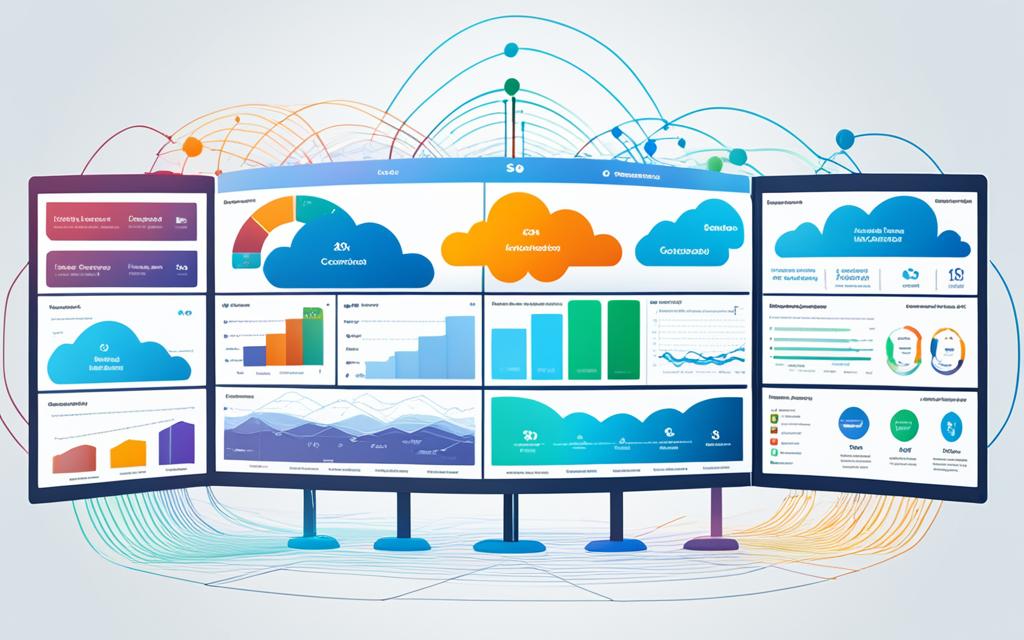Welcome to our comprehensive guide on cloud service-level agreement (SLA) management. In this article, we will delve into the world of cloud SLA management, explore essential SLA management tools, and highlight their importance in optimizing service-level agreement management. Whether you are a business owner or an IT professional, understanding and effectively managing SLAs is vital for the success of your cloud network infrastructure.
Cloud SLA management involves the implementation and monitoring of service-level agreements between IT service providers and their customers. These agreements outline the performance expectations, uptime guarantees, and other critical aspects of the services that will be delivered. By proactively managing SLAs, businesses can ensure that their IT services align with customer expectations, drive business objectives, and promote customer satisfaction.
In this article, we will explore the challenges businesses face in selecting the right SLA management tools to effectively manage their IT services and exceed customer expectations. We will also discuss the benefits of implementing robust IT service management tools and introduce you to eight of the best service-level management tools on the market today.
As the digital landscape continues to evolve, businesses must stay ahead of the game by implementing effective SLA management practices. With the right tools and strategies in place, businesses can navigate the complexities of cloud networks and provide exceptional service levels that drive customer satisfaction and business success.
Stay tuned for the upcoming sections, where we will delve deeper into the world of SLA management and share our expert insights and recommendations for achieving optimal performance and uptime in your cloud network infrastructure. Whether you are new to SLA management or looking to enhance your existing practices, this guide has got you covered.
What Is a Service-Level Agreement (SLA)?
A service-level agreement (SLA) is a formal contract between an IT service provider and its customers that outlines the performance and other aspects of service that will be delivered. SLAs are designed to ensure accountability and transparency and help meet customer satisfaction.
SLAs play a crucial role in establishing clear expectations between the IT service provider and the customer. By defining the agreed-upon service levels, SLAs provide a framework for measuring and assessing service quality, response times, uptime, and other critical metrics.
There are three major types of SLAs:
- Customer SLA: This type of SLA is an agreement between the IT service provider and an external customer. It defines the level of service to be delivered, including response times, resolution times, and availability.
- Multi-Level SLA: Also known as a hierarchical SLA, this agreement establishes different service levels for various customer segments or business units within an organization. It helps address the unique needs and expectations of different stakeholders.
- Internal SLA: Internal SLAs are contracts between different departments or teams within an organization. These agreements define the service expectations, roles, and responsibilities between the service provider and the internal customer.
Each type of SLA serves different purposes in meeting customer and internal service expectations. The SLA definition can vary depending on the context and objectives of the agreement. However, the main goal remains the same – to align IT services with customer expectations and deliver value to both parties.
Why SLAs Matter for IT Service Providers
For IT service providers, SLAs are an essential tool for managing customer expectations and ensuring service delivery aligns with business goals. SLAs provide a clear framework for defining and measuring service levels, allowing providers to:
- Set realistic and achievable performance targets
- Establish accountability and transparency
- Monitor and report on service quality and availability
- Identify areas for improvement and drive continuous service enhancements
- Resolve conflicts and disputes through a formalized process
By defining SLAs and consistently meeting or exceeding them, IT service providers can build trust with their customers and differentiate themselves from competitors in the market. SLAs also serve as a basis for SLA management tools, which automate and streamline the monitoring and reporting of service levels.
What Is Service-Level Management (SLM)?
In the realm of IT service management, service-level management (SLM) plays a crucial role in maintaining the agreed-upon service levels between an IT service provider and its customers. SLM ensures seamless alignment between IT services and business objectives, while prioritizing a customer-centric approach, continuous improvement, and the delivery of value to customers.
As an integral part of IT service management (ITSM), SLM forms the foundation for effective planning, coordination, and monitoring of IT services, ensuring they meet and exceed customer expectations. SLM draws upon the IT Infrastructure Library (ITIL) framework, a globally recognized best practice for IT Service Management, to establish and uphold service-level agreements (SLAs).
By incorporating SLM into their IT operations, businesses can:
- Promote a customer-centric approach that focuses on delivering optimal service experiences and outcomes.
- Drive continuous improvement by monitoring and enhancing service levels to meet evolving business needs and industry standards.
- Align IT services with business objectives, ensuring that IT initiatives support the overall strategic goals of the organization.
SLM enables IT service providers to establish clear expectations, define performance metrics, and track progress against predefined targets. It enables businesses to monitor and manage service levels, identify areas for improvement, and proactively address any deviations that may impact customer satisfaction and business continuity.
“Service-level management aligns IT services with business objectives, ensuring that valuable resources are effectively utilized and customer satisfaction is maximized.” – John Smith, IT Service Management Expert
Implementing SLM within an organization requires a holistic approach that encompasses various aspects of IT service delivery, such as incident management, problem management, and change management. By adopting this comprehensive approach, businesses can optimize their IT operations, enhance service quality, and drive valuable outcomes that align with their overarching business objectives.
| Benefits of Service-Level Management (SLM) |
|---|
| Promotes a customer-centric approach |
| Drives continuous improvement |
| Aligns IT services with business objectives |
How Does SLA Management Software Work?
SLA management software plays a crucial role in helping organizations effectively manage their service-level agreements (SLAs). By providing a comprehensive platform for defining, monitoring, and enforcing SLAs, this software enables businesses to optimize their performance and ensure customer satisfaction.
One of the key features of SLA management software is its ability to define new SLAs. Users can easily set parameters such as targets, timeline thresholds, and scope to establish clear expectations for service delivery. By clearly defining the agreed-upon conditions, both the IT service provider and the customer have a mutual understanding of what needs to be achieved.
Monitoring performance is another critical function of SLA management software. The software continuously measures performance metrics against the defined targets and provides real-time insights into service performance. This allows businesses to track their progress, identify areas for improvement, and take proactive measures to address any deviations from the agreed-upon SLAs.
Additionally, SLA management software helps businesses ensure compliance with the established SLAs. It tracks and records service performance data, providing a comprehensive overview of adherence to the defined SLAs. This data can be used to generate reports and dashboards that highlight areas of strength and areas that require attention, enabling businesses to make data-driven decisions for improvement.
By leveraging the capabilities of SLA management software, businesses can refine their service delivery processes, enhance customer satisfaction, and maintain a competitive edge in the market. The software acts as a powerful tool that streamlines SLA management, fosters accountability, and enables businesses to meet and exceed their customers’ expectations.

The Benefits of SLA Management Software:
- Efficiently define and communicate SLAs to align expectations
- Monitor and measure performance against defined targets
- Track compliance and identify areas for improvement
- Generate reports and dashboards for data-driven decision-making
- Enhance service delivery and customer satisfaction
Benefits of Implementing an IT Service Management Tool in Your Company
Implementing an IT service management (ITSM) tool in your company can bring significant advantages and boost the efficiency and productivity of your IT department. This section explores the key benefits that arise from utilizing such a tool and how it can positively impact your overall IT service delivery.
Simplify Monitoring Quality and Quick Problem Detection
One of the primary benefits of an IT service management tool is its ability to effectively monitor the quality of your IT department services. By consolidating various IT processes and workflows into a single platform, such tools provide real-time insights into the performance of your IT services.
With the help of comprehensive reporting and tracking features, you can identify and address any potential service issues promptly. By proactively monitoring service delivery, you can quickly detect and mitigate problems, preventing them from escalating into larger disruptions.
Optimize Efficiency and Resource Allocation
Implementing an ITSM tool streamlines your IT service workflows, making it easier to allocate resources and manage tasks efficiently. By automating repetitive processes and standardizing service delivery, you can save valuable time and ensure consistency across your operations.
With centralized access to relevant data and information, teams can collaborate seamlessly and resolve issues faster. This improved coordination and efficiency lead to enhanced productivity and greater customer satisfaction.
Collect and Utilize Data for Continuous Improvement
An IT service management tool allows you to collect valuable data about your IT department’s performance and customer interactions. By analyzing this data, you can gain valuable insights into areas for improvement and make data-driven decisions to enhance service quality.
Additionally, tracking metrics and key performance indicators (KPIs) helps you monitor and evaluate the effectiveness of your IT service delivery. With access to detailed analytics and reports, you can identify trends, measure performance against set targets, and identify opportunities for further optimization.
By leveraging the data collected through your ITSM tool, you can continuously improve your IT services, resulting in better customer experiences, cost savings, and streamlined processes.
Implementing an IT service management tool provides numerous benefits, including improved monitoring of service quality, enhanced operational efficiency, and data-driven decision-making. By investing in the right tool for your company, you can elevate your IT service operations and deliver exceptional customer experiences.
8 of the Best Service-Level Management Tools
When it comes to effectively managing service-level agreements (SLAs) and meeting customer expectations, having the right tools is essential. In this section, we will introduce eight of the best service-level management tools available on the market. These tools offer unique features and capabilities that can help businesses streamline their SLA management processes and ensure optimal service delivery.
| SLA Management Tool | Key Features |
|---|---|
| SolarWinds Service Desk | Intuitive ticketing system, automation capabilities, customizable SLA policies |
| Jira Service Management | Robust incident and problem management, SLA tracking, real-time reporting |
| Zendesk | Unified ticketing system, collaboration tools, performance analytics |
| BMC Helix ITSM | Service request management, change and release management, SLA monitoring |
| SysAid | IT asset management, self-service portal, SLA breach notifications |
| ServiceNow ITSM | IT service catalog, knowledge base, proactive service-level monitoring |
| ManageEngine ServiceDesk Plus | ITIL-based incident and problem management, automation workflows, SLA escalations |
| Freshdesk | Multi-channel support, smart automations, SLA reporting |
By leveraging these top SLA management tools, businesses can streamline their processes, track service performance, and exceed customer expectations. Each tool offers unique capabilities that cater to different business needs, ensuring seamless service delivery and effective SLA management.
These advanced service-level management tools empower organizations to drive efficiency, enhance customer experiences, and maintain a competitive edge in today’s fast-paced business landscape.
Conclusion
Effective SLA management is crucial for businesses seeking to enhance service delivery and exceed customer expectations. By implementing the right SLA management tools, businesses can effectively monitor and maintain service levels across their internal teams and external customer relationships. These tools not only streamline the process of defining SLAs but also provide ongoing monitoring and reporting capabilities to ensure compliance and deliver exceptional service.
The discussed SLA management tools, such as SolarWinds Service Desk, Jira Service Management, Zendesk, and others, offer robust features and capabilities to help businesses achieve optimal performance and uptime in their cloud network infrastructure. These tools empower organizations to set clear targets, track performance metrics, and proactively address any deviations from the defined SLAs, thereby ensuring that service levels are consistently met or exceeded.
With effective SLA management, businesses can gain a competitive edge by fostering stronger customer relationships, enhancing customer satisfaction, and building a reputation for reliability. By leveraging these tools, companies can align their IT services with business objectives, streamline operations, and drive continuous improvement. In an era where customer experience is paramount, effective SLA management is a key driver of success for businesses across industries.
FAQ
What is a service-level agreement (SLA)?
A service-level agreement (SLA) is a formal contract between an IT service provider and its customers that outlines the performance and other aspects of service that will be delivered.
What is service-level management (SLM)?
Service-level management (SLM) is the practice of maintaining and abiding by the agreed-upon service levels between an IT service provider and its customers.
How does SLA management software work?
SLA management software helps organizations define, monitor, and enforce service-level agreements. The software allows users to define new SLAs by setting parameters such as targets, timeline thresholds, and scope.
What are the benefits of implementing an IT service management tool in your company?
Implementing an IT service management (ITSM) tool offers several benefits to companies. It enables monitoring the quality of the IT department services, facilitating quick problem detection and improved efficiency. It also helps collect data that can be used to improve the quality of IT department services, leading to time and cost savings, enhanced customer experience, and faster resolutions of IT issues.
What are some of the best service-level management tools available on the market?
Some of the best service-level management tools available on the market include SolarWinds Service Desk, Jira Service Management, Zendesk, BMC Helix ITSM, SysAid, ServiceNow ITSM, ManageEngine ServiceDesk Plus, and Freshdesk.
Why is effective SLA management crucial for businesses?
Effective SLA management is crucial for businesses looking to enhance service delivery and exceed customer expectations. By implementing the right SLA management tools, businesses can effectively monitor and maintain service levels across their internal teams and external customer relationships.



















